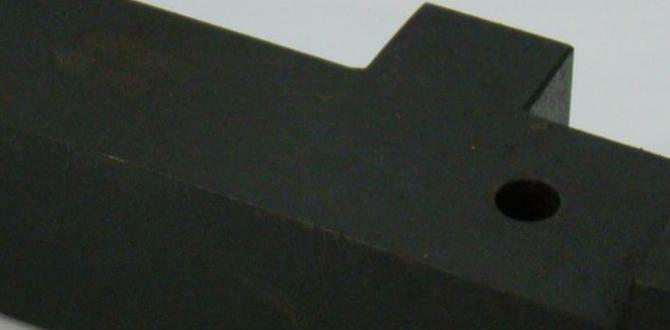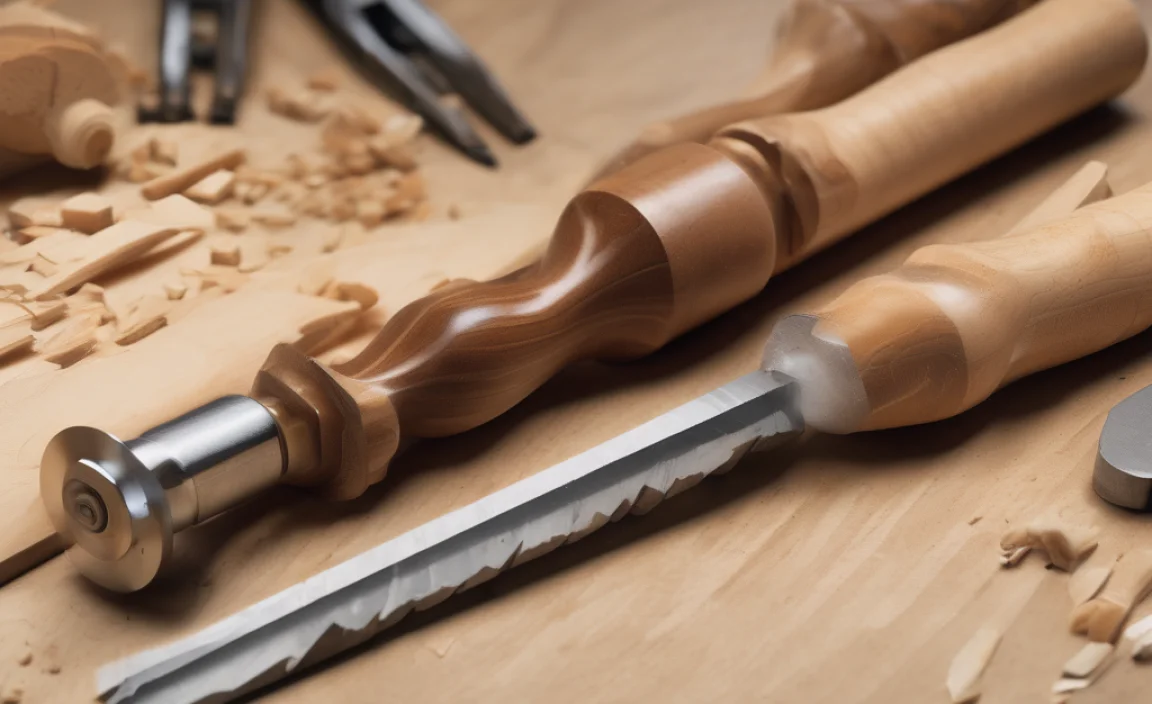Quick Summary:
A 3/16-inch carbide end mill with an 8mm shank and reduced neck is a specialized tool designed for efficient wood chip evacuation. This design allows for deeper cuts and cleaner finishes in intricate woodworking projects by preventing chip packing and tool overheating.
Hey there, workshop buddies! Daniel Bates here from Lathe Hub. Ever tried to carve a detailed design or slot a tight groove in wood, only to have it packed with chips? It’s frustrating, right? It can lead to rough cuts, tool breakage, and a lot of extra cleanup. But don’t worry! There’s a clever tool designed to make this much easier: the 3/16-inch carbide end mill, especially those with features for better chip evacuation. We’re going to dive into how this particular tool can be a game-changer for your woodworking projects, keeping things clean and smooth. Get ready to say goodbye to chip buildup!
Understanding the 3/16 Inch Carbide End Mill: More Than Just a Cutter
When you’re working with wood, especially on a CNC router or a milling machine, managing the chips that are produced is a big deal. These chips aren’t just messy; they can cause real problems. If they don’t escape the cutting area properly, they can get packed tightly around the end mill. This is called ‘chip packing,’ and it’s a machinist’s nightmare. It leads to increased friction, which means more heat. Overheated tools dull faster, and wood can scorch, leaving ugly burn marks. Worse, the pressure from packed chips can break the tool itself or damage your workpiece. That’s where specialized end mill designs come in, and the 3/16-inch carbide end mill with enhanced chip evacuation is a shining example.
A standard end mill might have two or four flutes, which are the spiral grooves that do the cutting and help move chips. However, for certain woodworking applications, especially those involving deep pockets or slotting, these flutes can become overwhelmed. This is where the genius of certain designs shines. We’re talking about tools specifically engineered to make chip removal a breeze. Let’s break down what makes these particular end mills so effective.
What Makes a 3/16 Inch Carbide End Mill Ideal for Wood Chip Evacuation?
The effectiveness of a 3/16-inch carbide end mill in clearing wood chips comes down to a few key design aspects. Carbide is a fantastic material for cutting tools because it’s incredibly hard and wears down much slower than high-speed steel (HSS). This means it can maintain a sharp edge for longer, even when subjected to the heat and friction of cutting wood. But hardness alone isn’t enough for efficient chip removal. Several other features contribute to a smooth, clean cutting process:
- Carbide Material: As mentioned, carbide’s hardness allows for faster cutting speeds and longer tool life. It also holds a very sharp edge, which is crucial for clean cuts in wood.
- Flute Design: The number and geometry of the flutes are vital. For wood chip evacuation, end mills with fewer, more open flutes are often preferred. Single-flute or two-flute designs offer more space for chips to exit.
- Coating: Some carbide end mills feature special coatings (like TiN, TiCN, or a mirror polish) that reduce friction and prevent material buildup, further aiding chip flow.
- Helix Angle: A steeper helix angle (the angle of the flutes) can help to ‘screw’ chips out of the cut more effectively.
The specific focus today is on a 3/16-inch carbide end mill. This size is versatile for many detail-oriented woodworking tasks, from creating intricate inlays to CNC carving. But for it to perform at its best, especially in challenging situations, we need to look at features that actively help clear wood chips.
The “Genius” Features: Reduced Neck and 8mm Shank
Now, let’s talk about the specific features that make a 3/16-inch carbide end mill truly outstanding when it comes to wood chip evacuation: the reduced neck and the 8mm shank. These aren’t just fancy terms; they represent smart engineering designed to solve common woodworking problems.
Understanding Flutes and Chip Spaces
Before we dive into the specific features, it’s important to understand flutes. These are the helical grooves that run along the cutting end of the mill. They perform two primary functions: cutting the material and carrying away the chips. The space between the flutes is called the flute gullet. For efficient chip evacuation in woodworking, a larger gullet is generally better because it can hold and transport more chips away from the cutting surface. End mills designed for plastic or wood often have fewer flutes (one or two) and larger gullets compared to those designed for tougher metals.
A typical 3/16-inch end mill might have two or four flutes. While four flutes offer a smoother finish on some materials due to more cutting edges engaged, they can sometimes lead to chip packing in softer materials like wood, especially when slotting. Single-flute and two-flute designs provide significantly more open space within the flutes, allowing chips to escape more freely.
The Role of the Reduced Neck
The “reduced neck” is a key innovation for enhanced chip evacuation. Imagine the main cutting part of the end mill. The neck is the area right behind the cutting edges, where the diameter of the tool starts to increase back to the full shank diameter. In a reduced neck design, this transition area is made thinner or more tapered than on a conventional end mill. Why is this genius?
- More Clearance: This “necking” provides extra space for chips to move away from the cutting zone. When the end mill is cutting deep slots or pockets, the chips can easily get trapped. A reduced neck essentially creates a wider highway for those chips to exit the flute without getting jammed.
- Reduced Friction and Heat: By clearing chips more effectively, less friction is generated. This means less heat buildup, which prevents wood scorching and extends the life of the carbide cutting edge.
- Deeper Cuts Possible: With better chip evacuation, the tool can handle deeper cuts in a single pass without sacrificing cut quality or risking tool damage. This can significantly speed up your machining time.
- Preventing Re-cutting: When chips can’t escape, they can get forced back into the cut. This is like trying to cut through sawdust with a dull knife – it’s inefficient and produces a poor result. The reduced neck helps ensure chips are cleared before they can be re-cut.
Think of it like clearing a clog in a pipe. If the pipe is narrow, debris gets stuck easily. If you widen a section of the pipe, the debris flows through much more freely. The reduced neck does exactly this for wood chips.
The Advantage of an 8mm Shank
Now, let’s consider the 8mm shank. While many end mills might come with standard imperial shanks (like 1/4″ or 1/2″), an 8mm shank (which is approximately 0.315 inches) offers specific advantages, especially when paired with a 3/16-inch cutting diameter. When you see “carbide end mill 3/16 inch 8mm shank reduced neck,” it typically means the cutting diameter is 3/16″, but the part that goes into your collet or tool holder is 8mm.
- Secure Grip: An 8mm shank provides a slightly larger diameter than a 1/4-inch shank (which is about 6.35mm). This slightly larger diameter, when held in an appropriately sized collet, can offer a more robust and secure grip on the end mill, especially at higher speeds or under heavier cutting loads.
- Compatibility with Tool Holders: Many CNC machines and routers use metric collets and tool holders. An 8mm shank is a standard metric size, making it readily compatible with a vast range of professional and hobbyist CNC equipment. You might find that your R8 collets or common ER collet sets have an 8mm option.
- Balance and Stability: A slightly larger shank diameter can sometimes contribute to better tool balance and overall stability during operation, especially when the end mill is being pushed hard.
- Reduced Flex: While the cutting diameter is small (3/16″), the shank diameter plays a role in how much the tool might flex under cutting forces. An 8mm shank, compared to a smaller one, can offer a bit more rigidity, helping maintain accuracy.
The combination of these features – the hard-wearing carbide, the efficient 3/16-inch cutting diameter, the extra chip clearance from the reduced neck, and the secure fit of the 8mm shank – creates a tool that’s purpose-built for high-performance woodworking cuts.
Applications for Your 3/16 Inch Carbide End Mill
This specialized 3/16-inch carbide end mill isn’t just a theoretical marvel; it’s a practical tool that shines in several common and advanced woodworking applications. Its ability to clear chips efficiently means you can achieve professional-level results with less hassle.
CNC Routing and Carving
For anyone using a CNC router for woodworking, precision and chip management are paramount. When creating intricate carvings, detailed inlays, or 3D surfaces, the end mill needs to move in complex paths. A standard end mill can quickly become bogged down with chips in tight corners or deep pockets. The 3/16-inch, reduced-neck, 8mm shank end mill excels here:
- Detail Work: The 3/16-inch diameter is perfect for fine details, lettering, and intricate patterns.
- Pocketing: The geometry is ideal for clearing out material in pockets or dados, preventing chip buildup that can jam the tool or burn the wood.
- 3D Contouring: In 3D carving, the tool constantly enters and exits the material at various angles and depths. Efficient chip evacuation ensures a smooth, consistent finish without witness marks from packed chips.
V-Carving and Engraving
V-carving uses specialized V-shaped bits, but end mills are also used for creating lines and channels. A 3/16-inch end mill can be used to create wider channels or as part of a multi-step carving process. The reduced neck design ensures that as the tool cuts deeper to create wider grooves, the chips are efficiently removed, preventing scorching and ensuring clean edges. This is particularly important in engraving where precise lines are key.
Dadoes and Grooves
Cutting dadoes (grooves with square ends) or other types of grooves for joinery can be challenging. If the chip load is too high or the chips can’t escape, you’ll end up with a rough, possibly burned groove. The improved chip evacuation of this end mill allows for faster, cleaner cuts, making joinery much easier and more precise.
Intarsia and Marquetry
These techniques involve cutting precisely shaped pieces of wood to fit together like a puzzle. The accuracy and clean cut edges provided by a high-quality carbide end mill are essential. The chip evacuation feature means you get crisp, clean cuts for perfect joinery, even in tight curves or complex shapes.
General Slotting and Profiling
Whether you’re creating slots for mechanisms, decorative elements, or simply profiling the edge of a workpiece on a CNC, this end mill will perform admirably. Its design is a step up from basic end mills when you need reliability and a superior finish, especially in deeper cuts.
Choosing the Right Carbide End Mill: What to Look For
When you’re out shopping for your 3/16-inch carbide end mill, especially one geared towards wood chip evacuation, it’s good to know what specific features to prioritize. Beyond the 3/16-inch size, 8mm shank, and reduced neck, there are other aspects that contribute to a tool’s performance and longevity.
Material and Grade of Carbide
Carbide isn’t just one thing; there are different grades. For woodworking, a general-purpose or slightly finer-grained carbide is often ideal for holding a sharp edge and resisting chipping. You don’t typically need the ultra-hard, coarse grades used for some metal cutting. Look for descriptions that mention ‘sub-micron grain’ or similar terms, indicating a fine, strong carbide structure.
Number of Flutes and Helix Angle
As discussed, for wood chip evacuation, fewer flutes are generally better.
- Single-Flute: Offers the most open space for chip removal. Excellent for softer woods and materials where chip load is a concern. Can sometimes result in a slightly rougher finish than a two-flute.
- Two-Flute: A great balance between chip evacuation space and finishing capability. This is often the most versatile choice for general woodworking on CNC.
- More than two flutes: Usually reserved for harder materials or when a very smooth finish is paramount, but can lead to chip packing in wood.
The helix angle affects how aggressively the flute cuts and moves chips. A steeper helix angle (e.g., 30-45 degrees) is generally good for chip evacuation, while a shallower angle might be better for certain finishes or very hard materials.
Coatings
While not always essential for wood, coatings can provide extra benefits:
- Uncoated (Mirror Polish): Many high-quality carbide end mills for wood are simply left uncoated and polished to a mirror finish. This reduces friction and provides excellent chip flow on its own and is often preferred by woodworkers.
- Aluminum-Specific Coatings (e.g., AlTiN): Sometimes used, but can be overkill and more expensive for wood.
- General-Purpose Coatings (e.g., TiN – Titanium Nitride): Can offer some added wear resistance, but often, a polished uncoated carbide is best for wood.
For wood, a mirror-polished, uncoated carbide end mill, especially with a reduced neck, is often the top choice for chip evacuation.
Upcut vs. Downcut vs. Straight Flutes
This refers to the direction the flutes are intended to move chips:
- Upcut Flutes: Helical grooves that spiral upwards. These are the most common for wood routing because they pull chips UP and out of the cut, preventing them from packing at the bottom of a slot. They also help to lift the material, allowing for better chip clearance.
- Downcut Flutes: Spiral downwards. These are used to hold the material down onto the spoilboard, creating a cleaner top edge but can pack chips into the cut. Less ideal for chip evacuation.
- Straight Flutes: Non-helical. Less common in woodworking CNC, better for general-purpose milling where chip evacuation is not a primary concern.
For excellent wood chip evacuation and a clean top edge, an upcut spiral end mill is generally the best choice, especially one with a reduced neck.
Tool Length Options
Consider the depth of cuts you plan to make. End mills come in various lengths. A longer end mill allows for deeper passes, but it also increases the risk of tool deflection or vibration. For deep cuts with a 3/16-inch carbide end mill, a reduced neck is even more critical for rigidity and chip evacuation.
How to Use Your 3/16 Inch Carbide End Mill Safely and Effectively
Using any cutting tool requires care and attention to safety. While a 3/16-inch carbide end mill is a marvel of design, proper technique will ensure you get the best results and stay safe in your workshop. This also applies to using it with CNC machines, which often have their own safety protocols.
Setting Up Your Machine
- Collet and Holder: Ensure your collet and tool holder are clean and free of debris. A proper fit is essential for a secure grip. For an 8mm shank, use an 8mm collet (or a set that includes 8mm). A worn or loose collet is a major safety hazard.
- Workpiece Security: Your workpiece must be clamped down firmly. Any movement during cutting can lead to inaccurate results or dangerous tool binding.
- Dust Collection: Even with good chip evacuation from the tool itself, fine dust will be produced. Ensure your dust collection system is active and effective to keep your workspace clean and your lungs healthy.
Machining Parameters (Speeds and Feeds)
This is crucial. Incorrect speeds and feeds are the most common cause of poor performance and tool breakage. For wood, these can vary greatly depending on the type of wood (hardwood vs. softwood), the depth of cut, and the specific end mill. The manufacturer of the end mill usually provides recommended parameters, or you can find general guidelines online. For example, a typical starting point for a 3/16″ carbide end mill in softwoods might be around 18,000-24,000 RPM with a feed rate of 30-60 inches per minute. However, these are just starting points.
Key concepts:
- Spindle Speed (RPM): How fast the end mill spins. Too fast can burn the wood; too slow can lead to poor chip formation.
- Feed Rate (IPM or mm/min): How fast the tool moves through the material. Too fast can overload the tool and lead to breakage; too slow can cause burning due to excessive friction.
- Depth of Cut (





